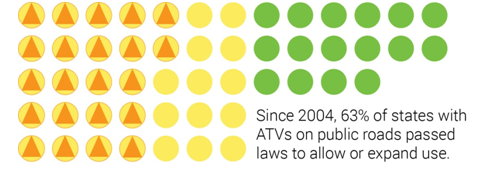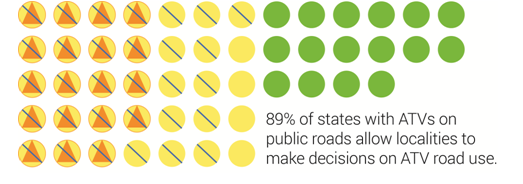Washington, D.C. – In a report released today, Consumer Federation of America (CFA) documents a growing public health crisis on America’s roadways. Each year, an increasing number of states and localities are passing state laws and local ordinances allowing all-terrain vehicles (ATVs) to legally operate on public roads. Further, a majority of ATV deaths occur on roads.
In the report, “ATVs on Roadways: A Safety Crisis,” CFA evaluated laws from all fifty states and the District of Columbia. The report finds that in spite of warnings from manufacturers, federal agencies, and consumer and safety advocates that ATVs are unsafe on roadways, for several years an increasing number of states have passed laws allowing ATVs on public roads. In this report CFA also analyzes recent research on ATV fatalities on roadways and provides recommendations to reverse this dangerous trend.
Information from ATV manufacturer manuals, required warning labels, and consistent messages from the U.S. Consumer Product Safety Commission (CPSC) unambiguously warn against the operation of ATVs on public roads. The design of ATVs makes them incompatible with operation on roads. ATVs have high centers of gravity, and narrow wheel bases, which increase the likelihood of tipping when negotiating turns. The low pressure knobby tires on ATVs are explicitly designed for off road use and may not interact properly with road surfaces.
“ATVs should not be operated on roads. Yet, an increasing number of states ignore evidence from consumer advocates, doctors, law enforcement officials and the ATV industry and pass laws increasing ATV access on roads. These conflicting messages are leading to consumer confusion about what constitutes safe riding practices,” stated Rachel Weintraub, Legislative Director and Senior Counsel for Consumer Federation of America. “This trend is going in the wrong direction.”
Data from the U.S Consumer Product Safety Commission and from the National Highway Transportation Safety Administration’s (NHTSA) Fatality Analysis Reporting System (FARS) documents that a majority of ATV deaths take place on roads.
- According to the CPSC’s most recent complete data from 2007, as analyzed by the Insurance Institute for Highway Safety, 492 of 758 deaths, or 65% of ATV fatalities occurred on roads.
- According to CPSC’s data, ATV on-road deaths have increased more than ATV off road deaths.
- According to NHTSA’s FARS database, 74% of ATV deaths occur on paved roads.

“The vast majority of ATV fatalities in the nation are occurring on roads,” stated Rachel Weintraub. “This is incredibly strong evidence supporting that ATV on-road operation is hazardous and should be prohibited.”
The CFA analysis of state laws found:
- 35 states, or 69% of states, allow ATVs on certain roads under certain conditions.

- Of these 35 states, 22 states, or 63%, have passed laws allowing or expanding ATV access on roads since 2004. Four states have passed such laws in 2013 alone.

- 31 of the 35 states, or 89%, that allow ATVs on paved roads delegate some or all of the decisions about ATV access to local jurisdictions with authority over those roads.

- While not a complete list, CFA documented at least 18 state or local current efforts to increase ATV access on roads.
“There is a clear 10 year trend toward increasing legal ATV access on roads that shows no sign of abating given the many examples of pending proposals,” said Michael Best, Policy Advocate at Consumer Federation of America. “While state laws vary about how they increase ATV access to roads: permitting certain classes of roads to be open to ATVs (Florida); delegating ATV access decisions to local authorities (Iowa); and allowing ATVs to be registered as a motor vehicle (Arizona)—any type of access to roads is dangerous.”
CFA’s report calls for immediate action at the municipal, county, state, and federal level to prohibit ATVs on roadways.
- State Laws: States should pass laws prohibiting ATV use on all roadways. State laws should not delegate authority over ATV access to local jurisdictions.
- Municipal and County Ordinances: Where state laws allow local jurisdictions to make decisions regarding ATV access to public roads, those jurisdictions should not expand the permissible range of ATVs on roads.
- National Highway Traffic Safety Administration: ATVs are not under NHTSA’s jurisdiction; however, since states are increasingly passing laws permitting on road use and ATV deaths are occurring primarily on roads, NHTSA should take concrete steps to address ATV safety. NHTSA should share data with the CPSC and expand its current grant programs that fund enforcement efforts to ATVs.
- The Consumer Product Safety Commission: As the agency responsible for ATV safety, the CPSC should be a strong voice in opposing the operation of ATVs on roads and in educating consumers about the dangers of on road ATV use. Additionally, the CPSC could improve ATV death data by including how many deaths occur on private versus public roads.
- The ATV Industry: All segments of the ATV industry need to prioritize opposition to laws and ordinances allowing ATVs on roads.
- All ATV Stakeholders: All those interested in and working on ATV safety need to work together to prioritize opposition to efforts to expand ATV operation on roads.
“Consumer and health and safety advocates, federal regulators, and all segments of the ATV industry must work together to prevent ATVs from operating on roads,” stated Rachel Weintraub. “ATVs on roads are a serious public health risk and action must be taken now to protect consumers from this grave hazard.”
Contact: Rachel Weintraub, CFA (202) 387-6121
The Consumer Federation of America is an association of nearly 300 nonprofit consumer organizations that was established in 1968 to advance the consumer interest through research, advocacy, and education. www.consumerfed.org

